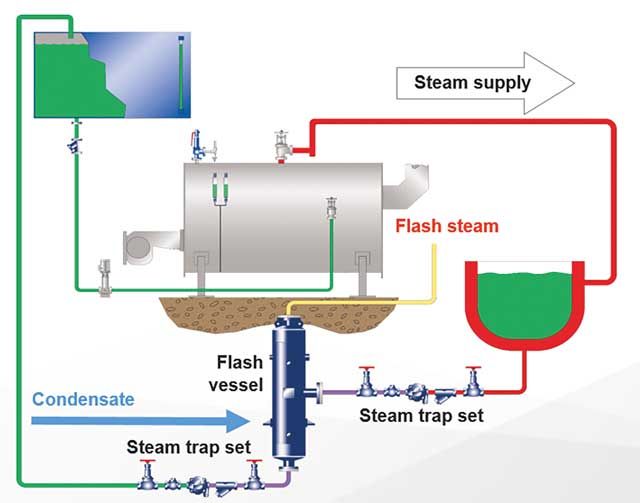 Boilerhouse managers and operators are constantly battling with rising energy prices. Chris Coleman, boilerhouse national specialist at Spirax Sarco, argues truly efficient condensate recovery can boost productivity at low cost
Boilerhouse managers and operators are constantly battling with rising energy prices. Chris Coleman, boilerhouse national specialist at Spirax Sarco, argues truly efficient condensate recovery can boost productivity at low cost
Steam is used in a wide range of industrial processes. For users of steam, it’s no longer enough to strike a good deal on energy supplies or achieve high levels of productivity: now they are expected to do both, while complying with a complex web of regulation.
Striking the right balance can make a crucial, tangible contribution to your company’s revenue flow, but, with ageing equipment and economic uncertainty coming into play, the potential to achieve that is virtually impossible. That is, until you consider your use of condensate and the heat you may have otherwise wasted.
The value of condensate
In industrial steam applications, steam moves through the system, where it transfers a proportion of its heat into whatever it is heating, and turns back into water – or condensate. Condensate is hot, which is what makes it useful it is as a resource. Condensate generated by a steam heating system will normally retain about 25% of the energy that the steam had, and contains little or no dissolved solids.
Allowing condensate to drain away, rather than re-using it, can result in water and effluent management costs, which can be significant. Similarly, draining condensate can make it harder to comply with environmental regulatory standards for effluent. In many countries, including the UK, condensate often has to be cooled before it can be drained which, again, will come at an extra cost.
Put bluntly, those who are disposing of their condensate are throwing money away. Recovering and re-using as much of it as possible can have huge financial advantages.
How can condensate be put to better use?
1. Boiler feedwater
If condensate is not used as feedwater, the boiler must be topped up continually with cold water. This is costly both in water and energy, because the cold feedwater must be heated. Condensate reduces the need for (and cost of) fresh water and treatment chemicals, and requires much less energy than cold make-up water does to be ready for use.
2. Flash steam recovery
Flash steam can be harvested and re-used. It is formed when high pressure condensate undergoes a large pressure drop, often created during the blowdown process. A flash vessel is one method that can be used to recover energy by separating flash steam from condensate. As condensate enters the flash vessel, flash steam is produced; it can then be piped from the top of the vessel to the feedtank through the deaerator.
Flash steam is produced in the boiler blowdown process, and the use of both a flash vessel and plated heat exchanger pack will allow recovery of up to 80% of the energy from the rejected total dissolved solids water (effulent removed from the boiler during blowdown to keep total dissolved solids within prescribed limits), which can also result in fuel savings and a reduction in carbon dioxide emissions.
The recovery process
How condensate is recovered can broadly be summarised in three important steps.
1. Steam traps are used to remove condensate from the steam system. A steam trap survey can often offer invaluable insight into the performance of a system, and will almost certainly reveal impressive savings potential through reduced fuel consumption, fuel emissions, water, and effluent charges.
2. Pumps are used to return condensate to the boiler feedtank.
3. Condensate is mixed with other feedwater to heat it in the feedtank.
Condensate recovery is one process that is genuinely capable of boosting boiler efficiency, saving energy, increasing equipment life and complying with legislation – all of which can, in turn, generate substantial savings to those who use steam systems.
Rising energy costs are having a major impact on all types of businesses in every industry. Saving energy from condensate is a simple yet highly effective technique. It may not take the leading role in the steam system, but it is undeniably the unsung hero of the boilerhouse.
Spirax Sarco’s full report, The unsung hero of boiler house efficiency, is available to download from http://sxscom.uk/boilerhouseefficiency.

